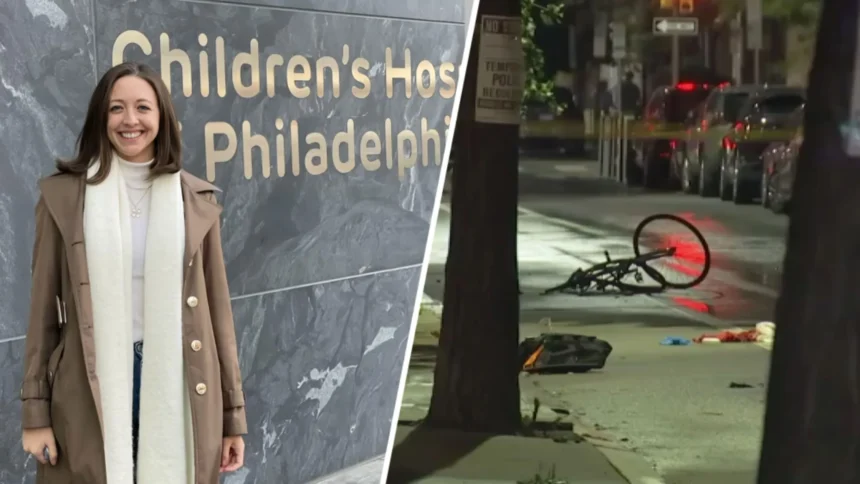On July 17, 2024, Dr. Barbara Friedes died from biking in a bike lane close to Rittenhouse Square.
It happened when she crossed the road and Michael Vahey, 69-year-old, who was driving the car at a speed of 50+ mph, with the upper limit of blood alcohol level above the legal limit.
Barbara Friedes was also wearing a helmet but her head was badly damaged and she succumbed to her injuries shortly after she was rushed to Jefferson University Hospital.
Immediate Aftermath of the Accident
When Dr. Barbara Friedes was killed in a bike accident in a special bike lane, despite wearing a helmet.
Emergency teams quickly got to the scene. She died at Jefferson University Hospital right after being taken there.
Her death deeply affected her coworkers and other cyclists, leading to many people holding a memorial and calling for better bike safety.
Her parents, John and Mary Dietrick, blamed the accident on bad traffic safety and urged for big changes in Philadelphia’s traffic rules, showing that many believe these accidents are avoidable.
The Role of Alcohol in the Tragedy
The driver was Michael Vahey and he was drunk. His blood alcohol level showed that it was above the legal limit.
He was also breaking speeds in a given zone that has restricted speed limits. This incident clearly underlines the need for tighter DUI legislation and with special reference to bikers.
Others opine today’s penalties are insufficient to discourage drunk driving especially in towns cyclists frequently use.
Mourning and Mobilization
Many people had the desire to make changes after the sudden death of Dr. Barbara Friedes from her workplace and many of her friends and family friends.
Some of her parents John Dick and Mary Dietrick vowed to ensure that their daughter’s death resulted in worthwhile alteration and improved conditions for bike riders.
It was important to them that her story be used to push change and not simply be used as an example of the number of women killed.
Cycling people also shared this aim; they had vigils and demanded wider bike lanes which would have concrete barriers to ensure such mishaps do not recur.
The Push for Safer Infrastructure
The bike lanes in Philadelphia, especially after Dr. Barbara Friedes’ death has been a big issue.
Many lanes, like those on Spruce Street, use temporary posts that some say don’t keep cyclists safe enough from cars.
These posts have been blamed for not stopping accidents, like the one that killed Dr. Barbara Friedes, where a fast car went over them.
Now, there’s a push to make these lanes safer by using permanent concrete barriers and getting rid of parking in them.
Groups like the Bicycle Coalition want big changes to make biking safer and prevent more deaths.
Vision Zero
The Vision Zero project aims at eliminating fatalities and serious injuries in traffic by designing safer facilities and routes, increasing legal compliance with traffic laws by drivers and other road users, and raising public awareness about the risks.
This is being implemented in Philadelphia to address the high traffic fatalities, and for people like cyclists and pedestrians.
But as the issues of cutting down on the budget recently have emerged there are concerns that it may not be as successful. The budget has slashed Vision Zero projects funding from $2.5 million to $1 million in the latest budget.
While the city has invested $1.25 million in a programme to reduce speeding, some people are worried that the funds are going to offset some essential initiatives for cyclists such as protection for bike lanes and changes to roads.
Advocacy Groups Unite
Organizations such as the Bicycle Coalition of Greater Philadelphia and Philly Bike Action are among those that seek to increase the rate of cycling in Philadelphia.
The Bicycle Coalition still focuses on making bike paths better and enlisting the community, meanwhile Philly Bike Action wants the protected bike lanes to be as interconnected as possible.
These groups came together to honor Dr. Barbara Friedes; they managed to mobilize members of the community to get more than ten thousand signatures for bike lane protection and more funding for Vision Zero.
They also conducted their protests at the City Hall so that city administrators could hear their grievances and the need to secure cycling on Philadelphia roads after Barbara Friedes’ death proved that cyclists’ lives are at risk.
Legislative Actions and City Government Response
After Dr. Barbara Friedes’ death, city leaders in Philadelphia are working to make cycling safer.
Kenyatta Johnson has proposed a new law to stop cars from blocking bike lanes, which would lead to bigger fines.
This move shows a strong desire to protect cyclists, especially after Barbara Friedes’ passing. People want permanent barriers in bike lanes and have collected over 10,000 signatures for this.
They also want more money for Vision Zero, a plan to eliminate traffic deaths. However, budget cuts to Vision Zero are worrying, as it might be hard to make the big changes needed for cyclist safety.
The sad death of Dr. Barbara Friedes highlights the need for big changes in city traffic safety.
It’s important for city leaders to focus on protecting cyclists and improving road safety for everyone.


Leave a Reply